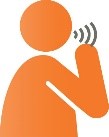Set Training Goals
People silo STD’s and HIV but they really involve the same approach as any other illness… HIV is not so special.
– Senior Nurse Manager
Consider Overall Project Goals
Training plays a crucial role in the success of large-scale change like HIV testing. To develop a detailed list of training objectives, work backward from your over-arching, long-term project goals. For example, we wanted to test 26,000 patients by the end of the project and to set up systems so that opt-out testing would continue beyond our funding window.
You might start with a preliminary goal of informing the staff of the project and its goals. Communicate that the project exists, and share as widely as possible its purpose and goals. We broke this larger goal up into smaller objectives:
 |
Increase awareness of the opt out HIV testing project, its purpose, and its goals |
 |
Share plans to integrate the project fully and seamlessly into clinic workflows |
 |
Share plans for staff to actively intervene to inform patients “We test everyone” for HIV as a part of routine health care, including the first point of care (medical receptionists), at vitals and intake (MAs), during case management (RNs), and with providers (primary care providers, residents and NPs). |
Train for Cultural and Systems Changes
Next, look at your implementation plans and examine how you plan to accomplish your testing goals. From there, develop specific training goals that include everything you want staff to understand and do. For example, we had an overall project goal of normalizing routine HIV testing at all nine sites. To do this, we planned staff trainings that incorporated efforts to change knowledge, attitudes and beliefs of both staff and patients about HIV testing. But more than just providing information and changing attitudes, we also provided staff with tools and information to actually implement HIV testing. We included this “how to” information in our training plans.
Set out detailed outlines of what you want staff to learn, and use this information to generate training materials. For us, a typical overview training covered the following:
 |
Share stories about how we impact patients’ lives |
 |
Discuss why we’re testing all patients 15 and older for HIV |
 |
Discuss why HIV screening is relevant here |
 |
Introduce or follow up on standardized workflows |
 |
Set targets |
Include Desired Outcomes and Measurements of Success
Be sure to include specific system and cultural outcomes in your training plans. Our plan included the following cultural competencies for clinical staff:
 |
Knows how HIV is and is not transmitted |
 |
Feels comfortable speaking about HIV and informing patient that we test everyone |
 |
Knows about HIV treatments, including nPEP, PrEP, and ART |
The plan also included the following system competencies:
| Sees HIV lifetime screening alert in their patient panel | |
| HIV Screening template is added as a favorite within their panel | |
| Knows how to document patient declines and set reminder for patient test at next visit (or in 3-6 months) | |
| Knows how to order lab or perform rapid (where applicable) | |
| Knows how to perform rapid tests (where applicable) | |
| Knows how to document rapid test results (where applicable) |
Create data reports and an Evaluation Plan to measure your progress towards these outcomes.
Resources
- Quick Facts on HIV – HIV.gov: U.S. government HIV website with up-to-date statistics and other HIV and AIDS information
![$logo['alt']](https://srhealth.org/wp-content/uploads/2017/03/srch-logo-1.png)